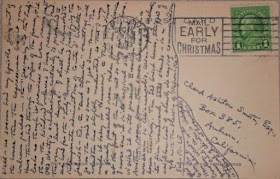54 years ago today, Clark Ashton Smith died. Part of what is called the "Triumvirate" of Weird Tales writers (which also includes Robert E. Howard & H.P. Lovecraft), Smith left a legacy of excellent poetry and stories. In Memoriam, here are a few samples of his work along with a few quotes . . .
“Bow down: I am the emperor of dreams;
I crown me with the million-colored sun
Of secret worlds incredible, and take
Their trailing skies for vestment when I soar,
Throned on the mounting zenith, and illume
The spaceward-flown horizons infinite.”
From
The Last Oblivion: Best Fantastic Poetry of Clark Ashton Smith
“To me, the best, if not the only function of imaginative writing, is to lead the human imagination outward, to take it into the vast external cosmos, and away from all that introversion and introspection, that morbidly exaggerated prying into one's own vitals—and the vitals of others—which Robinson Jeffers has so aptly symbolized as "incest." What we need is less "human interest," in the narrow sense of the term—not more. Physiological—and even psychological analysis—can be largely left to the writers of scientific monographs on such themes. Fiction, as I see it, is not the place for that sort of grubbing.”
"In his bleak mercy, Death forever strips The soul of light and memory, rendering blind Our vision, lest surmounted deeps appal, As when on mountain-heights a glance behind Betrays with knowledge, and the climber slips Down gulfs of fear to some enormous fall." from
The Unremembered
“Not as the plants and flowers of Earth, growing peacefully beneath a simple sun, were the blossoms of the planet Lophai. Coiling and uncoiling in double dawns; tossing tumultuously under vast suns of jade green and balas-ruby orange; swaying and weltering in rich twilights, in aurora-curtained nights, they resembled fields of rooted serpents that dance eternally to an other-worldly music.”― from Lost Worlds
Below is a letter from Robert E. Howard to Clark Ashton Smith postmarked March 15, 1933, thanking Smith for a story and lamenting about the demise of Strange Tales magazine:
Dear Mr. Smith:
I hardly know how to thank you for the copy of The Double Shadow. I have read the stories with the most intense interest and appreciation, and hardly know which I like the best. All are magnificent, splendid examples of that poetic prose which is so characteristic of your work. I envy you your rich and vivid style.
It was a pity that Strange Tales went out of circulation, and I am sorry that the magazine's demise left so many of your stories unpublished. They had only one of my yarns when they quit. However, I sold them only three stories, altogether.
I am very glad that you have found the Conan series of interest, and appreciate very much the kind things you said about the yarns. I shall look forward with eager anticipation for "The Dark Eidolon" and the other stories you mentioned to be published in Weird Tales. Incidentally, your story in the current Weird Tales is splendid.
I am enclosing a check for Ebony and Crystal and would feel most honored if you would write your autograph on the fly page.
Thanking you again for the magnificent Double Shadow, I am,
Most cordially yours,
REH
Here's another letter to Smith from REH dated July 23, 1935 . . .
Dear Mr. Smith:
I'm ashamed of my long delay in answering your letter, but I assure you it was from no lack of interest. Since writing you last a number of things have combined to interfere with my correspondence: a month I was forced to spend in East Texas, during time I did no writing of any kind; a journey to Santa Fe, New Mexico; and a number of shorter trips to various points in West Texas, and the necessity of catching up on my fiction work which accumulated during the time spent on these trips, all caused me to get away behind on my letter-writing.
But I have, as always, followed your work in Weird Tales. I very much enjoyed "Dark Eidolon", "The Last Hieroglyph", "The Flower Women", and the splendid poem: "Dominion". I am not exaggerating when I say that I do not consider that I ever read a finer poem than that. I'd give my trigger-finger for the ability to make words flame and burn as you do.
I've been concentrating on adventure stuff recently, trying to break into that field permanently. I've made a start, with yarns published in Action, Thrilling Adventures, and Top-Notch; got a couple of covers designs in a row with Top-Notch and am toiling manfully to become a regular contributor. Sent a three-part serial to Wright yesterday: "Red Nails", which I devoutly hope he'll like. A Conan yarn, and the grimmest, bloodiest and most merciless story of the series so far. Too much raw meat, maybe, but I merely portrayed what I honestly believe would be the reactions of certain types of people in the situations on which the plot of the story hung. It may sound fantastic to link the term "realism" with Conan; but as a matter of fact - his supernatural adventures aside--he is the most realistic character I ever evolved. He is simply a combination of a number of men I have known, and I think that's why he seemed to step full-grown into my consciousness when I wrote the first yarn of the series. Some mechanism in my sub-consciousness took the dominant characteristics of various prizefighters, gunmen, bootleggers, oil field bullies, gamblers, and honest workmen I had come in contact with, and combining them all, produced the amalgamation I call Conan the Cimmerian.
Lovecraft tells you are doing some impressive work in carving, using dinosaur bone; I envy you your splendid variety of talent--artist, poet, author, and now sculptor.
With best wishes.
Cordially,
Robert E. Howard
_______________________________





















